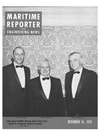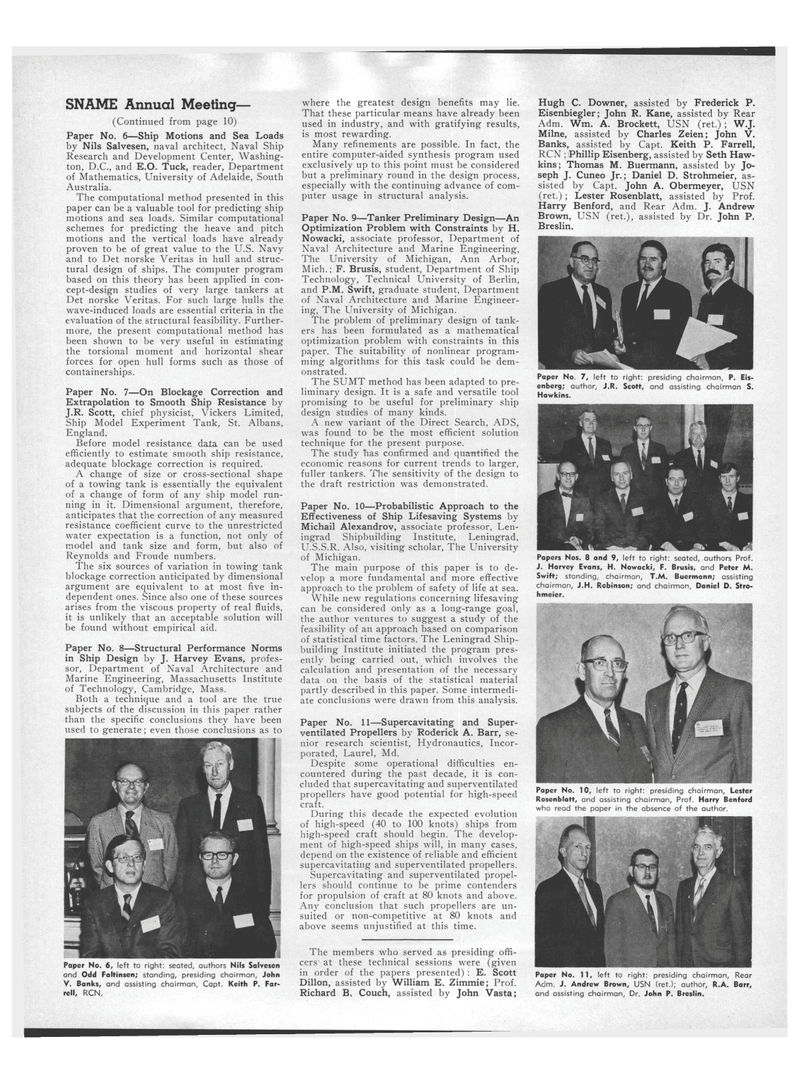
Page 10: of Maritime Reporter Magazine (December 15, 1970)
Read this page in Pdf, Flash or Html5 edition of December 15, 1970 Maritime Reporter Magazine
SNAME Annual Meeting— (Continued from page 10)
Paper No. 6—Ship Motions and Sea Loads by Nils Salvesen, naval architect, Naval Ship
Research and Development Center, Washing- ton, D.C., and E.O. Tuck, reader, Department of Mathematics, University of Adelaide, South
Australia.
The computational method presented in this paper can be a valuable tool for predicting ship motions and sea loads. Similar computational schemes for predicting the heave and pitch motions and the vertical loads have already proven to be of great value to the U.S. Navy and to Det norske Veritas in hull and struc- tural design of ships. The computer program based on this theory has been applied in con- cept-design studies of very large tankers at
Det norske Veritas. For such large hulls the wave-induced loads are essential criteria in the evaluation of the structural feasibility. Further- more, the present computational method has been shown to be very useful in estimating the torsional moment and horizontal shear forces for open hull forms such as those of containerships.
Paper No. 7—On Blockage Correction and
Extrapolation to Smooth Ship Resistance by
J.R. Scott, chief physicist, Vickers Limited,
Ship Model Experiment Tank, St. Albans,
England.
Before model resistance data can be used efficiently to estimate smooth ship resistance, adequate blockage correction is required.
A change of size or cross-sectional shape of a towing tank is essentially the equivalent of a change of form of any ship model run- ning in it. Dimensional argument, therefore, anticipates that the correction of any measured resistance coefficient curve to the unrestricted water expectation is a function, not only of model and tank size and form, but also of
Reynolds and Froude numbers.
The six sources of variation in towing tank blockage correction anticipated by dimensional argument are equivalent to at most five in- dependent ones. Since also one of these sources arises from the viscous property of real fluids, it is unlikely that an acceptable solution will be found without empirical aid.
Paper No. 8—Structural Performance Norms in Ship Design by J. Harvey Evans, profes- sor, Department of Naval Architecture and
Marine Engineering, Massachusetts Institute of Technology, Cambridge, Mass.
Both a technique and a tool are the true subjects of the discussion in this paper rather than the specific conclusions they have been used to generate; even those conclusions as to
Paper No. 6, left to right: seated, authors Nils Salvesen and Odd Faltinsen; standing, presiding chairman, John
V. Banks, and assisting chairman, Capt. Keith P. Far- rell, RCN. where the greatest design benefits may lie.
That these particular means have already been used in industry, and with gratifying results, is most rewarding.
Many refinements are possible. In fact, the entire computer-aided synthesis program used exclusively up to this point must be considered but a preliminary round in the design process, especially with the continuing advance of com- puter usage in structural analysis.
Paper No. 9—Tanker Preliminary Design—An
Optimization Problem with Constraints by H.
Nowacki, associate professor, Department of
Naval Architecture and Marine Engineering,
The University of Michigan, Ann Arbor,
Mich.; F. Brusis, student, Department of Ship
Technology, Technical University of Berlin, and P.M. Swift, graduate student, Department of Naval Architecture and Marine Engineer- ing, The University of Michigan.
The problem of preliminary design of tank- ers has been formulated as a mathematical optimization problem with constraints in this paper. The suitability of nonlinear program- ming algorithms for this task could be dem- onstrated.
The SUMT method has been adapted to pre- liminary design. It is a safe and versatile tool promising to be useful for preliminary ship design studies of many kinds.
A new variant of the Direct Search, ADS, was found to be the most efficient solution technique for the present purpose.
The study has confirmed and quantified the economic reasons for current trends to larger, fuller tankers. The sensitivity of the design to the draft restriction was demonstrated.
Paper No. 10—Probabilistic Approach to the
Effectiveness of Ship Lifesaving Systems by
Michail Alexandrov, associate professor, Len- ingrad Shipbuilding Institute, Leningrad,
U.S.S.R. Also, visiting scholar, The University of Michigan.
The main purpose of this paper is to de- velop a more fundamental and more effective approach to the problem of safety of life at sea.
While new regulations concerning lifesaving can be considered only as a long-range goal, the author ventures to suggest a study of the feasibility of an approach based on comparison of statistical time factors. The Leningrad Ship- building Institute initiated the program pres- ently being carried out, which involves the calculation and presentation of the necessary data on the basis of the statistical material partly described in this paper. Some intermedi- ate conclusions were drawn from this analysis.
Paper No. 11—Supercavitating and Super- ventilated Propellers by Roderick A. Barr, se- nior research scientist, Hydronautics, Incor- porated, Laurel, Md.
Despite some operational difficulties en- countered during the past decade, it is con- cluded that supercavitating and superventilated propellers have good potential for high-speed craft.
During this decade the expected evolution of high-speed (40 to 100 knots) ships from high-speed craft should begin. The develop- ment of high-speed ships will, in many cases, depend on the existence of reliable and efficient supercavitating and superventilated propellers.
Supercavitating and superventilated propel- lers should continue to be prime contenders for propulsion of craft at 80 knots and above.
Any conclusion that such propellers are un- suited or non-competitive at 80 knots and above seems unjustified at this time.
The members who served as presiding offi- cers at these technical sessions were (given in order of the papers presented) : E. Scott
Dillon, assisted by William E. Zimmie; Prof.
Richard B. Couch, assisted by John Vasta;
Hugh C. Downer, assisted by Frederick P.
Eisenbiegler; John R. Kane, assisted by Rear
Adm. Wm. A. Brockett, USN (ret.) ; W.J.
Milne, assisted by Charles Zeien; John V.
Banks, assisted by Capt. Keith P. Farrell,
RCN ; Phillip Eisenberg, assisted by Seth Haw- kins; Thomas M. Buermann, assisted by Jo- seph J. Cuneo Jr.; Daniel D. Strohmeier, as- sisted by Capt. John A. Obermeyer, USN (ret.); Lester Rosenblatt, assisted by Prof.
Harry Benford, and Rear Adm. J. Andrew
Brown, USN (ret.), assisted by Dr. John P.
Breslin.
Paper No. 7, left to right: presiding chairman, P. Eis- enberg; author, J.R. Scott, and assisting chairman S.
Hawkins.
Papers Nos. 8 and 9, left to right: seated, authors Prof.
J. Harvey Evans, H. Nowacki, F. Brusis, and Peter M.
Swift; standing, chairman, T.M. Buermann; assisting chairman, J.H. Robinson; and chairman, Daniel D. Stro- hmeier.
Paper No. 10, left to right: presiding chairman, Lester
Rosenblatt, and assisting chairman, Prof. Harry Benford who read the paper in the absence of the author.
Paper No. 11, left to right: presiding chairman, Rear
Adm. J. Andrew Brown, USN (ret.); author, R.A. Barr, and assisting chairman, Dr. John P. Breslin.

 9
9

 11
11
